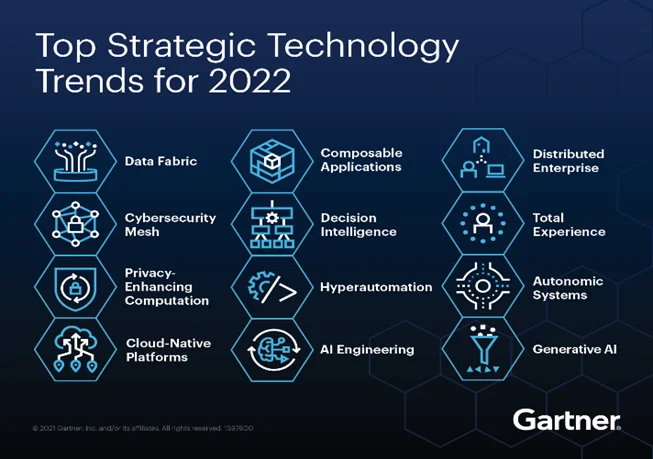GARTNER TOP STRATEGIC TECHNOLOGY TRENDS 2022

Gartner expects these 12 technology trends to act as force multipliers of digital business and innovation over the next three to five years. Here’s your quick guide to what the technologies are and why they’re valuable.

Every year, Gartner identifies technology trends that are critical to business. This year, the list comprises 12 strategic trends that will enable CEOs to deliver growth, digitalization, and efficiency — and position CIOs and IT executives as strategic partners in the organization. “CEOs know they must accelerate the adoption of digital business and are seeking more direct digital routes to connect with their customers,” says David Groombridge VP Analyst, Gartner. “But with an eye on future economic risks, they also want to be efficient and protect margins and cash flow.” (For more on the strategic value of these trends, see below.)
What are the 12 top strategic technology trends, 2022 — and why are they valuable?
Trend 2: Cybersecurity Mesh Cybersecurity mesh is a flexible, composable architecture that integrates widely distributed and disparate security services. Cybersecurity mesh enables best-of-breed, stand-alone security solutions to work together to improve overall security while moving control points closer to the assets they’re designed to protect. It can quickly and reliably verify identity, context and policy adherence across cloud and non - cloud environments.
Trend 3: Privacy-Enhancing Computation Privacy – enhancing computation secures the processing of personal data in untrusted environments — which is increasingly critical due to evolving privacy and data protection laws as well as growing consumer concerns. Privacy-enhancing computation utilizes a variety of privacy-protection techniques to allow value to be extracted from data while still meeting compliance requirements.
Trend 4: Cloud-Native Platforms Cloud – native platforms are technologies that allow you to build new application architectures that are resilient, elastic and agile — enabling you to respond to rapid digital change. Cloud-native platforms improve on the traditional lift-and-shift approach to cloud, which fails to take advantage of the benefits of cloud and adds complexity to maintenance.
Trend 5: Composable Applications Composable applications are built from business-centric modular components. Composable applications make it easier to use and reuse code, accelerating the time to market for new software solutions and releasing enterprise value.
Trend 6: Decision Intelligence Decision Intelligence is a practical approach to improve organizational decision making. It models each decision as a set of processes, using intelligence and analytics to inform, learn from and refine decisions. Decision intelligence can support and enhance human decision making and, potentially, automate it using augmented analytics, simulations, and AI.
Trend 7: Hyper automation Hyper automation is a disciplined, business-driven approach to rapidly identify, vet and automate as many business and IT processes as possible. Hyper automation enables scalability, remote operation and business model disruption.
Trend 8: AI Engineering AI engineering automates updates to data, models, and applications to streamline AI delivery. Combined with strong AI governance, AI engineering will operationalize the delivery of AI to ensure its ongoing business value.
Trend 9: Distributed Enterprises Distributed enterprises reflect a digital-first, remote-first business model to improve employee experiences, digitalize consumer and partner touchpoints, and build out product experiences. Distributed enterprises better serve the needs of remote employees and consumers, who are fueling demand for virtual services and hybrid workplaces.
Trend 10: Total Experience Total experience is a business strategy that integrates employee experience, customer experience, user experience and multi - experience across multiple touchpoints to accelerate growth. Total experience can drive greater customer and employee confidence, satisfaction, loyalty and advocacy through holistic management of stakeholder experiences.
Trend 11: Autonomic Systems Autonomic systems are self-managed physical or software systems that learn from their environments and dynamically modify their own algorithms in real time to optimize their behavior in complex ecosystems. Autonomic systems create an agile set of technology capabilities that are able to support new requirements and situations, optimize performance and defend against attacks without human intervention.
Trend 12: Generative AI Generative AI learns about artifacts from data, and generates innovative new creations that are similar to the original but doesn’t repeat it. Generative AI has the potential to create new forms of creative content, such as video, and accelerate R&D cycles in fields ranging from medicine to product creation. How the technology trends drive digital business.
Each delivers one of three main outcomes
Engineering Trust: Technologies in this segment create a more resilient and efficient IT foundation by ensuring data is integrated and processed more securely across cloud and non-cloud environments, to deliver cost-efficient scaling of the IT foundation.
Sculpting Change: By releasing the creative new-technology solutions in this area, you can scale and accelerate your organization’s digitalization. These technology trends allow you to respond to the increasing pace of change by creating applications more rapidly to automate business activities, optimize artificial intelligence (AI) and enable faster smarter decisions.
Accelerating Growth: By capitalizing on strategic technology trends in this segment, you’re unleashing IT force multipliers that will win business and market share. Together, these trends enable you to maximize value creation and enhance digital capabilities. Watch now, and see how three trends — generative AI, cybersecurity mesh and decision intelligence — will propel strategic change.
Commonly asked questions about top strategic technology trends
How can organizations use the list of top technologies?
CIOs and IT executives should use these trends to analyze how their organizations need to evolve their implementation and technology adoptions over the next three to five years.
How will the technology trends impact the business?
Organizations that adopt and plan for these trends will create long-term roadmaps for reliant and sustainable business growth.
How will these innovations affect organizations in the long term?
Some of these innovations represent underpinning technical capabilities required to compete in a digital world, while others provide business-oriented capabilities to step ahead of the competition.
How can we best identify candidate technologies and trends in support of operational resilience and business model change?
IT leaders are ideally placed to determine whether trends and disruptions are a threat or an opportunity. They can realize enterprise change by leveraging their knowledge of business and technology to understand the impact of trends on their organizations.
How can we fuse the assessment of emerging technologies within the broader context of nontechnology trends and consider the wider political, economic, social, legal and environmental trends? The Gartner TPESTRE analysis provides a framework for assessing all types of trends. It allows IT leaders to integrate an understanding of wider impacts into their technology planning.
What are the most impactful strategic and emerging technology trends? Different trends will impact different organizations in different ways. With a tight integration between most of the trends, varying combinations of technologies are likely to be required to compete at various times in the business growth cycle. Selecting the priority trends will revolve around CIOs and IT leaders understanding their organizations’ short-term and strategic business objectives.